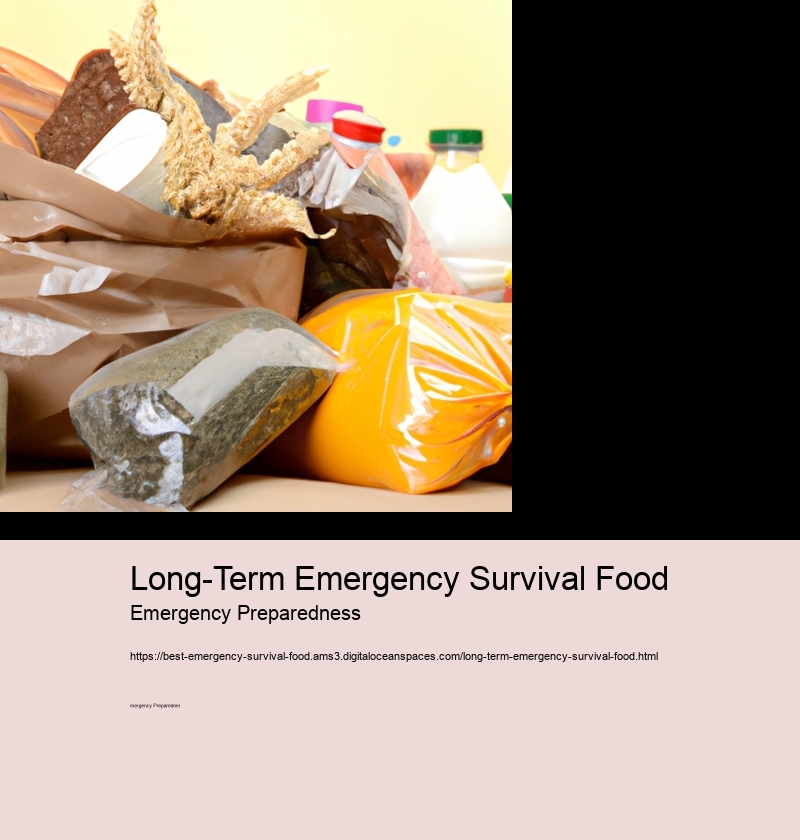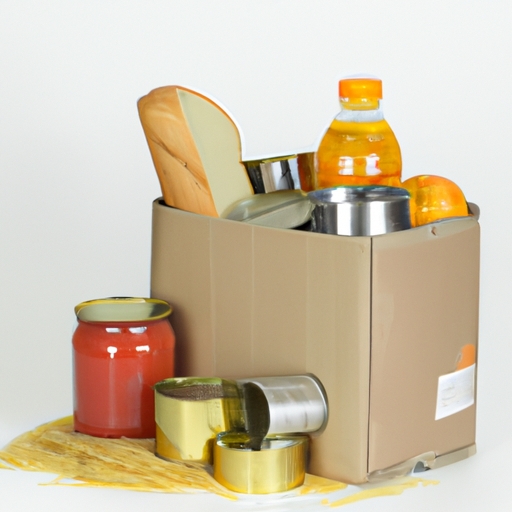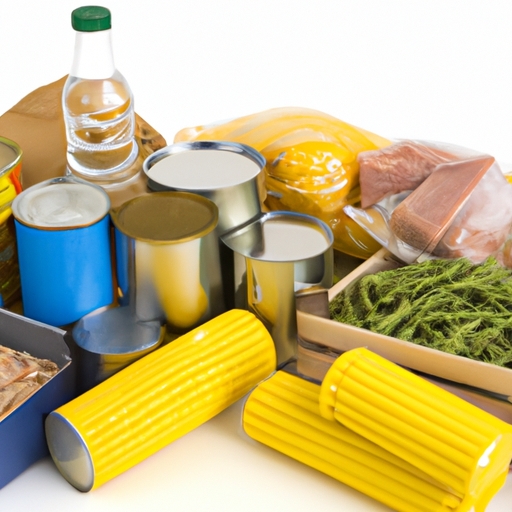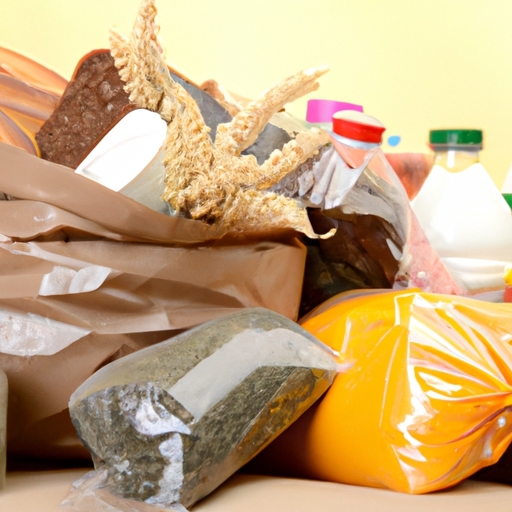Long-Term Emergency Survival Food
Introduction

Introduction
Introdction (to Long-Term Emergency Survival Food)
It's a wise idea to be prepared for any kind of emergency, and stocking up on food is an important part of that. Long-term emergency survival food will help you keep your family safe and secure in the event of a disaster.
These foods are specially formulated to last for long periods of time without spoiling or losing their nutritional value. They come in convenient packaging, so they can be easily stored and transported if needed. Some popular options include freeze-dried meals, canned goods, and dehydrated fruits and vegetables.
Nonetheless, these items may not always taste great! For that reason it is best to combine them with other nourishing snacks like nuts and energy bars for added flavor. Plus, don't forget to store water too - it's essential for keeping hydrated during tough times!
Also, (it's important to remember) that there are no hard-and-fast rules when it comes to stocking up on survival food; everyone needs something slightly different based on their dietary preferences and lifestyle choices.
Moreover, if you're looking for more information about this topic , there are lots of helpful resources available online!
In conclusion, having long-term emergency survival food is an absolute must - it could prove invaluable in the case of a disaster or other unforeseen situation! So why wait? Start stocking up today!!
Types of Long-Term Emergency Survival Food
Long-term emergency survival food is a critical component in preparing for any potential disaster. It's important to have a variety of items stocked up that will last through any dire situation. There are several types of sustenance that can be used to ensure sustenance during an extended period of time.
First, canned goods provide a great source of nutrition and can last years without needing to be refrigerated! This could include items such as fruits, vegetables, meats or fish. Additionally, foods like rice, pasta and beans aren't just delicious but also immensely economical. Another practical choice would be dehydrated meals which typically require no refrigeration and come in various sizes depending on your needs.
In addition to these staples, it's advisable to keep some snacks around too! These could include energy bars, trail mix and beef jerky; all perfect for providing both calories and essential nutrients when needed most. Furthermore, don't forget about condiments! Things such as salt, pepper and spices can make all the difference when it comes to making your meals more enjoyable.
Finally, having access to fresh water is essential for long-term survival food storage so investing in some good quality water filters should be considered (especially if you're trying to ration out what you have). Additionally(!), investing in a generator might not seem like something necessary at first thought but it could save lives; especially in situations where power isn't available!
To conclude(!), there are many different types of long-term emergency survival food options available so make sure you research thoroughly before deciding on what suits you best! Taking this precaution will help ensure that if the worst happens you'll be prepared with enough supplies for whatever life throws at ya!
Storage Considerations for Long-Term Emergency Survival Food
Long-term emergency survival food has many storage considerations to ensure it remains safe for consumption. It is important to use airtight containers with lids that seal completely (like mason jars) to keep the food from spoiling or becoming contaminated. It's also critical not to store the food in a moist area, as moisture can cause mold and bacteria growth, leading to rapid spoiling. Additionally, consider rotating through your stored foods regularly; this will help prevent items from going stale. A great way to do this is by using a first-in-first-out system, where you use the oldest items first!
Temperature is another key factor when storing emergency survival food. If temperatures are too high or too low, they can cause an imbalance of vitamins and minerals and render them ineffective nutritionally speaking. Ideally, store your long-term survival food in a cool, dark place where temperatures remain relatively constant; basements and cellars are great options here! Plus don't forget about rodents and pests - make sure any packages are sealed tightly so critters won't be tempted to snack on them!
Finally, labeling each container with dates is essential for keeping track of expiration times – nothing worse than having to throw away expired goods! And if you're unsure whether a product has gone bad or not just trust your senses – smell it first before consuming it. If it smells off in any way then discard it right away – better safe than sorry! Furthermore, try not to overstock on one particular item as well; variety is always best when it comes to long-term emergency survival food storage.
In conclusion, these simple yet effective storage considerations for long-term emergency survival food will ensure your supplies remain fresh and ready for use whenever needed!
Nutritional Value of Long-Term Emergency Survival Food
Long-term emergency survival food has great nutritional value! The (nutritional) content of the food is important for providing sustained energy and staying healthy. It often contains high amounts of proteins, vitamins, minerals and carbs that are essential for the body to function properly. In addition, some foods contain additional nutrients like fiber, antioxidants and other compounds that can help protect against disease.
However, not all long-term emergency survival food is equal in terms of nutrition. Some products may be highly processed or have added preservatives or sugar that can reduce their overall nutritional value. It's best to look for foods with no additives or artificial ingredients whenever possible. Additionally, it's a good idea to check labels carefully so you know exactly what you're getting before purchasing any product.
Plus, when stocking up an emergency supply of long-term survival food, it's wise to consider the shelf life as well as the nutrition content. Food items should last at least several months without spoiling if stored correctly; this will ensure they still provide adequate nourishment during extended periods without access to fresh produce. Ultimately, choosing nutritious but also shelf-stable options is key for ensuring optimal health during emergency situations!
Benefits of Long-Term Emergency Survival Food
Long-term emergency survival food is a great way to be prepared and safe for any potential disaster! It offers many benefits that can help ensure your safety and well-being in times of crisis. Firstly, it provides sustenance during prolonged periods where traditional food sources may not be readily available. Having an ample supply of long-term emergency survival food means you don't have to worry about finding nourishment or going hungry. (Moreover,) it can also reduce the amount of time spent foraging for food or waiting in line for rations.
Second, having a reserve of emergency survival food helps alleviate stress caused by uncertain situations. Knowing that you have access to something edible should make any grim situation less daunting. Additionally, these items are easy to store and often come with a long shelf life so you won't need to worry about them expiring before they're needed.
Finally, long-term emergency survival food allows you to remain self sufficient when resources are scarce or difficult to come by. This can prevent the need for costly trips out of town or other risky scavenging activities which could put your safety in jeopardy. In conclusion, having a stockpile of this type of item is essential if one wants to be as prepared as possible during an emergency situation!
Tips for Selecting the Best Long-Term Emergency Survival Food
Choosing the right long-term emergency survival food can be a daunting task! With so many options available, it's (hard) to know what to pick. However, there are some tips that can help you make an informed decision. Firstly, consider your dietary needs and choose foods that meet those requirements. Foods high in protein or carbohydrates may be more beneficial depending on your lifestyle. Secondly, think about shelf life - non-perishable items with a longer expiration date will last much longer than fresh ingredients. Thirdly, look for convenience; canned foods or freeze dried meals are often easier to prepare in an emergency situation.
Additionally, cost is an important factor when selecting long-term emergency food supplies. Look for bulk discounts and compare prices between different brands before committing to buy. Finally, don't forget flavor! Eating nutritious foods is important but having some variety of flavors will make these meals more enjoyable over time.
In conclusion, taking the time to carefully select the right long-term emergency food supplies can help ensure you're prepared when disaster strikes. Consider your dietary needs, shelf life, convenience and cost when making this critical decision!
Conclusion
Long-term emergency survival food can be a tricky subject to navigate. It's important (to have) a plan ahead of time, so you're not left scrounging for something to eat when the situation arises. With this (in mind), there are several options available when it comes to long-term emergency survival food.
Firstly, freeze dried and canned goods are great choices. These provide nutritous and tasty meals that can last up to 25 years! They require no cooking or special preparation, which makes them ideal for those who don't want to worry about preparing their meal during an emergency. Additionally, they are relatively inexpensive when compared with other forms of food storage.
Secondly, dehydrated foods offer another great option for long-term emergency survival food. These products come in many varieties such as fruits, vegetables, meats and grains – all of which provide nutritionally dense meals that will last much longer than fresh counterparts. Dehydrated foods also don't require any cooking or refrigeration – making them perfect for storing in small spaces and using on-the-go!
Finally, home preserved foods like jams and jellies are excellent sources of energy and nutrition during an emergency situation. You can store these items in jars or vacuum seal bags without needing a refrigerator or other electrical appliance. Home preserving is also cost effective – giving you greater control over your budget while still having a reliable source of sustenance throughout an emergency situation.
In conclusion, long-term emergency survival food is essential for anyone who wants to remain prepared in case of an unexpected event. Freeze dried and canned goods provide nutritous meals that will last for decades; dehydrated foods offer versatile options with no need for refrigeration; and home preserved produce gives you control over what goes into your storage containers while keeping costs low! All three methods should be considered carefully before selecting what works best for your individual needs!
Resources
When it comes to long-term emergency survival food, resources are key! Without them, the ability to sustain oneself during a disaster can be greatly hindered. The first step is to know what type of food is available and how it should be stored. Canned goods, grains, and proteins like beans and nuts are all examples of sustenance that can last for many months if stored correctly.
Next, consider your budget when stocking up on supplies. There are plenty of cost-effective options out there such as dried fruits and vegetables which can provide adequate nutrition without breaking the bank. Additionally, don't forget about things like water filters which will enable you to have clean drinking water no matter the situation!
Furthermore, having a plan in place for preparing meals during an emergency is essential. It's important to research recipes that require minimal ingredients or cooking time so that you're not wasting energy or valuable resources. Utilizing recipes like one pot dinners or slow cooker dishes are great ideas for conserving both energy and time while still providing nutritious meals.
Finally, knowing where to find more information if needed is crucial. In addition to local grocery stores or farmers markets, websites such as ReadyNutrition offer helpful tips for long-term emergency survival food prepartion and storage techniques as well as delicious recipes! (Don't forget about books too!) With these resources at hand, anyone can be prepared for any eventuality!
Emergency Survival Food Storage


